Jet engines, hearts, and planets: the world of digital twins
In this episode of The Naked Scientists, we'll be taking a closer look at digital twins. What are they, and could they be the future of engineering, healthcare, and climate science?
In this episode

What is a digital twin?
Richard Mortier, University of Cambridge
The advent of supercomputers, machine learning algorithms and artificial intelligence means that our ability to simulate and recreate real life scenarios is becoming ever more precise. And with that comes the question: can we save time, money and effort on improving our current infrastructure by simulating changes on near perfect digital copies, and then taking what worked best and applying it to their real world counterparts? That’s the thinking behind digital twins.
Will - To make a digital twin, you need a few things. First, a physical object or system that you want to replicate and monitor. That could be a building, an engine, a patch of woodland, pretty much anything. Then you need a way of monitoring that object. If it's an engine that could be checking changes in temperature. If it was a building, it could be measuring the number of people walking through it. Finally, you need a computer model that takes this sensory data and shows how it affects the physical object. If you've got all three, you've got yourself a digital twin. Here to talk us through more is the University of Cambridge's Richard Mortier.
Richard - People have obviously done modelling of complex systems, complex environments for decades. Building engines, building bridges, you will have a model of that. You're then going to engineer and build and deploy. And people have deployed monitoring infrastructure in physical systems for decades where you will have a heating system or something. You'll have various sensors in there that will tell you when something's going wrong or when maintenance needs to be done. But I think it's this bringing those two things together and coupling them together so that you can be continually feeding off the data that's coming out of the physical system and feeding that into the model, but then also feeding insights from the model into how you're managing and maintaining indeed through the whole life cycle. So it might be how, not just how you're managing and maintaining the system, but indeed how you're developing new instances of the system, perhaps how you're prototyping technologies before they're deployed. But that's the essence of it. It's this coupling behaviour between the statistical model and data and the physical system is what I would think of as additional to it.
Will - So already then you can imagine that creating any useful form of digital twin is going to require a lot of data, but obviously with such a wide array of possibilities, the amount of data involved heavily depends on what you are twinning.
Richard - Digital twins can be built for a very wide range of scales of things if you like. So you can have a digital twin for a bridge, or an engine, or the air traffic control system across the UK. So there's a very different set of scales that you can apply this kind of idea to. And kind of along with that, you can apply it at different points in the life cycle of those things. So you might have an additional twin that you start out with before you've actually even built the real thing. Or you may have only built components of the thing. You may be using a previous version of the thing that you're building a digital twin of, in order to feed data into the twin to see how the next version might be built and see how it might behave. You then may have digital twins that you build for particular instances of that thing. So you might have one for each of the engines that you have, you've sold around the planet, for example. And then you may also try to aggregate information from those digital twins because you'll obviously be obtaining information from the different instances as they are being used in practice and as they are evolving in their use in practice. And as those systems are degrading or changing behaviour as time passes as they get used. And so you can sort of look at the aggregate across those to try and build some idea of what would happen on average or what would happen, what the range of variation might be in the way that these physical systems behave.
Will - And this idea, whilst cutting edge, has been around for many years. In fact, the first digital twin may well have been that of the stranded Apollo 13 space mission, as the ground team created a twin of the tools that the astronauts had and found a way of getting them back to Earth. It's a great story if true, but whatever the case, the concept is certainly not new.
Richard - I think that it's probably one of those things which has kind of snuck up on people to an extent. In the sense that people have run simulations of large scale systems for, as I said, for decades and decades. The Met Office has been trying to predict weather for a very long time. And in some sense you can view that as a kind of digital twin for the weather system. But I suppose people didn't call it a digital twin until relatively speaking, relatively recently.
Will - So nowadays with all of our fancy AI and computer modelling, what does a digital twin look like? Are engineers congregating around holographic 3D representations of engines and moving parts around in virtual reality?
Richard - I suppose ultimately, at least in my head, a digital twin looks like, in most cases it'll be the physical thing itself and the sensing attached to that so that you've got the data feeds coming out of it, and then it looks like some software running on a computer.
Will - Oh… Well that's fine. I, you, you know, that's, that's not the point. The point is they're capable of taking data from a system and seeing where it can be maintained and improved.
Richard - Yes. That, or equally it's important that the line that comes out of the computer that says this wind turbine is going to fail in three days time and it's something that you can act upon and it doesn't need to have a fancy graphic, but you do need to see that information coming out of it.
Will - Okay, the visuals might need to work, but the technology is still here and very impressive. So where might we be headed?
Richard - So one of the things I'm interested in is seeing how, as usual with some of these technologies, I think how they migrate from the very kind of big ticket, high value projects where it's worthwhile people really, really doing the work and putting the investment in to understand these things. And as that technology starts to trickle down into more kinds of everyday environments, so the energy grid for example, you really, it's, it's worthwhile spending quite a lot of time and money to really understand how that's going to work and how that's going to function. But if some of that technology might be deployed into sort of the, you might start out looking at power stations or something really big and important and expensive like that. See what that technology could then be moved into a more domestic context, for example, particularly as we start to move to more microgeneration of energy with solar panels on people's houses and things like that. The degree to which those sorts of approaches will kind of become more pervasive in everyday life.
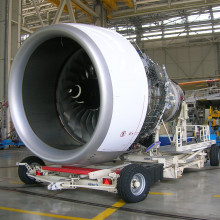
06:50 - Rolls-Royce's digital twin engines
Rolls-Royce's digital twin engines
Rob Fox, Rolls-Royce
One major player in the world of digital engines is the Aerospace company Rolls-Royce. Specialist in mechanical analysis Rob Fox explains what kinds of digital twins Rolls-Royce are currently involved in.
Rob - The answer to that question is that we're doing many types of digital twins, and I'll take you through a couple of examples. And they range from connected to unconnected digital twins. So a connected twin is something that's live monitored, so it's passing information back and forwards. We use those sorts of things to spot if engines aren't functioning as we intend. So we'd have a mathematical model of what speed and how hot we expect the engine to be, for example. And we'll be receiving data from flights at the service centre to tell us whether engines are behaving as we expect, and that'll allow us to schedule inspections or maintenance and things like that. Unconnected twins are generic models, but we'd update them offline. So that might be something like an engine on a test bed where we're going to undertake a very, very nasty test on it, and we would then produce that model and update it based on the parameters of the day and the conditions that we saw to give us a better indication as to how the engine performed under those testing conditions.
Will - What would be the data that is being sent back to you from these engines? Is it just a matter of temperature? Is it how well the parts are faring under pressure? What kind of stuff?
Rob - It would be dependent on the type of model, but to give an example for the connected twin, it would be things like shaft speed, so they'd be like the RPM that you would get in your car. So how fast are things running temperatures and pressures from within the engine, because obviously we would have an idea of what performance the engine is supposed to be providing and how its internal is supposed to be. So if it's running too hot or too cold, that will be important information for us. But then other things as well, like fuel flow, for example. So we'd know how efficiently the engine's operating, its fuel efficiency and also safety measures. So we'd monitor vibration within the engine and that way we'd know if things were changing within the engine, we'd spot those earlier and hopefully track engines through their life to see if they're suddenly changing as well.
Will - How often does all of this data from the engines come through back to you?
Rob - So the data being transmitted is obviously somewhat limited by the bandwidth available, but it is constant transmission from assets in service. So there's a lovely video on the internet of Rolls-Royce IntelligentEngine, which kind of gives a view of that. The data updates aren't many thousands of samples per second as you can imagine, because you've got thousands of hours of flights in real time. But the data is reasonably rapid updates within the confines of what we can save and and secure.
Will - So this sounds really useful in terms of being able to spot when something might wear out or break, but is it useful as well for potential improvements if you're prototyping an engine?
Rob - Absolutely. I mean, we would start with a generic understanding of how we expect a thing to be operated in service and we'll establish the life prediction for it. So, we will know that a particular part might be able to operate for say, a thousand flights or something like that. Usually very expensive parts if they're live. But if the aircraft is operated slightly less arduously, so fewer passengers on a particular flight, so the engine is operating at lower power settings. By measuring and knowing that we can then increase the operational life of those expensive parts and in development testing. So when we build an original engine, we'll start off and it will be quite a rough design, relatively speaking of course, and the performance. As we hone and improve our models, we can then get closer and closer and closer to the real understanding of the limits and conditions and can also manage how we operate it. So not push things, uh, quite so hard if we recognise that they're causing these issues.
Will - Yeah, I shudder to think how expensive, expensive parts are and stuff like aircraft and engines. So even with the complexity of creating a digital twin, does it therefore make more economic sense to do this than to build a second one and see how that fares instead?
Rob - Well, yeah I mentioned an unconnected twin. So my background is fan blade off testing. So we'll release a blade and we'll destroy an engine on a test bed. Anybody looks on YouTube, you'll see numerous videos of fan blade off tests. They're very exciting, but they're also very nerve wracking moments because you're taking a very, very expensive jet engine and you are essentially blowing it up. We make models of those before the test so we know that they're going to be successful, but you've still trashed an engine. And where we might wish to use an engine in different applications, so perhaps taking one that's been used in a civil context and used in military aircraft, you would not necessarily wish to redo a test that you already know is okay. So you take your digital twin of the test that you'd already performed, adapt that and avoid the necessity of performing a secondary test, which you already know the outcome of anyway, and would have very limited learning from. And that can save you many millions of pounds and many months in the development program for a new engine.
Will - From an environmental and resource management side as well, this is using a lot less stuff.
Rob - Absolutely, absolutely. I've mentioned predicting maintenance for example, if you have a generic understanding of how a part's going to be used in service, you might estimate that it can last a thousand flights and it's very expensive metals. If you can know exactly how a particular part is used, you can extend the life from a thousand to two thousand to five thousand flights. Then all of a sudden you are reducing the CO2 production simply from making the parts, you are also not taking the engine off wing. So it's been able to be in service much longer minimising the resource consumption whilst maximising the operation. And obviously that enables us then to use things for longer and get the full life out of everything rather than going with a worst case scenario and pulling something off just because we don't know what its condition is.
Will - You've got the environmental side covered, the economic side covered. Where are you planning on taking this sort of system next? What's the future of digital twins at Rolls Royce?
Rob - Probably an increased level of connectivity. You can imagine there are many thousands of aircraft flying around. They have very limited bandwidths of data transmission back to base. So increasing the degree of connectivity and the faster updates so we can hone even further still and really eke out every opportunity to get data, but also that'll enable us to make faster decisions as well. So rather than landing an aircraft with a suspicion that we need to look at the engine, we'd hopefully land with not only the suspicion, but knowing in more detail exactly what it's that we're going to look at. And also linking data together as well and various different twins. So examples would be for perhaps a part that we built on a test bed, we've assembled it and moved it around if we find that it's damaged in transit, having twins for transit as well as what testing was performed. You can ascertain whether the damage perhaps occurred when it was being tested, when it was being transferred, or when it was in the build shop and things like that.
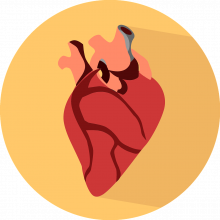
A digital twin of your own heart
Caroline Roney, Queen Mary University of London
How much could the technology of digital twins aid us in the diagnosis of cardiac disorders? Queen Mary University of London’s Caroline Roney…
Caroline - The average heart beats a hundred thousand times a day. But we don't really like to talk about averages because we work in personalised healthcare. And digital twins are all about personalising treatments to the patient. So although we'd like to have this regular heartbeat, what can actually happen is the top chambers of the heart, so the atrium, they can quiver rather than having a strongly coordinated contraction. And this irregular heart rhythm is called atrial fibrillation. And this is a bad thing for patients because it increases the risk of stroke and heart failure and it reduces the quality of life. And there are treatments for atrial fibrillation, including antiarrhythmic drugs and catheter ablation therapy. But there's actually a very big variation between patients, and this is why this is a good candidate for digital twins because all of our hearts are different. So we have different shapes, different sizes, the hearts. We have differences in our electrical properties and our scar tissue. And all of these properties together mean that which treatment is best and whether a treatment is likely to work will vary between patients.
Will - So how do you go about making a digital twin of the heart? Say, I came in and I was worried about my atrial fibrillation. What kind of data would you take and how would you input it into a meaningful system?
Caroline - So you might have some imaging done, so you might have an MRI or a CT scan. If you have that done, then that means that we can get a really detailed picture of the shape of the heart. We'd be able to make a personalised anatomy. That's a model that's personalised to your specific anatomy, but it's not just about the shape of the heart. We also need to be able to capture the electrical properties. So if we have your electrical signals or your ECG, we can use that data then to calibrate the digital twin and to calibrate the mathematical model. And then once we have this virtual beating heart, we can then try out different treatments. So we could burn different areas of the heart in different places to see whether that's likely to work, or we can add different antiarrhythmic drugs to the virtual twin, or we can do combinations of the two. Actually, like for anyone who's interested in cardiac digital twins, there's a new exhibit at the moment at the Science Museum where you can see a very cool beating heart. It's a patient specific model. You can see it beating, you can see the blood flow, and this will give you an idea for what these models look like.
Will - Now, as you said at the beginning of this, the heart is always beating a hundred thousand times a day. So are you always taking data? Is there something attached to the wearer that allows them to get a continuous stream of information about the heart?
Caroline - It depends on what we're modelling. So sometimes we might make a model that's based just on imaging data and a single ECG, and that captures how the patient is at that moment in time. But as you say, it's very important to include how we change over time, and particularly after having a procedure to get an idea of how the heart's changing. So in those cases, we're moving towards using wearables, so we're moving towards using Apple Watch or Fitbit and taking the signals from there. But that's kind of the next step of our modelling to include that longitudinal data and to really update the model over time.
Will - How does this improve diagnosis and treatment in a way that previous methods haven't?
Caroline - One of the ways that we're approaching our modelling is we really want to include data from large populations of patients and combine this with patient specific models so that you have the advantages of what you've learned across large populations of data, but together with patient specific models which capture lots of the physics and the physiology of the problem and their personalised to the patient. And we found that by combining these two approaches and adding the patient specific models to our predictions, we were able to improve our predictions of the long-term outcome of atrial fibrillation procedures by 30%.
Will - That's a remarkable difference.
Caroline - Yeah. So I think going forwards, it's really going to be, in my opinion, about combining the two approaches so that you get the advantages of the large data sets and what we know across populations and on what works. And we use machine learning to combine that with the detailed physics-based models.
Will - It sounds like then, given that this is so broadly applicable but also fantastically specialised to the individual, it could help vast amounts of people.
Caroline - So there's 1.5 million people in the UK at the moment with atrial fibrillation. So it is a large health problem, and digital twins in healthcare can be applied across all different organs and all different diseases. So I hope this will be a very exciting area and have real impact.
Will - Do you think then that the future could well be, I mean the heart is one system and a fairly complicated one at that, could you envisage full body versions of digital twins that incorporate all kinds of organs and systems?
Caroline - I think it's possible, but we do have a way to go to make these virtual human twins the whole body because it's very complicated to couple together all of the different systems, but we are actually already thinking about the logistics of this. We need to really think about how to store the data, share models and deploy in the clinic. So at Queen Mary, we're part of a large initiative that's led by the Virtual Physiological Human Institute that's about how to make an ecosystem for digital twins in healthcare. So this is really thinking about how we store our data? How can we share our models, deploy in the clinic about the ethics of it and really about sustainability as well. So as part of that initiative, we're focusing on some use cases like cardiovascular. There's a cancer use case or osteoporosis and intensive care, but the overall vision is to do this, to move towards a whole virtual human twin. But I think that'll be in the future.
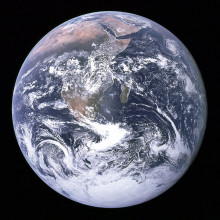
21:09 - A digital twin of the entire planet
A digital twin of the entire planet
Irina Sandu, European Centre for Medium-Range Weather Forecasts
What is the upper limit of digital twinning? Well, how about a digital twin of the entire planet. That is the premise of ‘Destination Earth’, a project from the European Commission which, by 2030, aims to produce an interactive computer simulation of the whole of planet Earth. One of the organisations involved in this herculean task is The European Centre for Medium-Range Weather Forecasts. Their director for Destination Earth is Irina Sandu...
Irina - As we saw over recent years and even more so over recent months, the climate urgency is amplifying. We are entering uncharted territory. The global mean temperature is rising constantly. We just experienced the first day where the global mean temperature was two degrees warmer than the pre-industrial period. So what inspired the project is really the digital twin concept, together with the recognition that the latest breakthroughs in digital technologies, in supercomputing, in science, and in artificial intelligence, have the potential to enable us to create a digital twin of our planet.
Will - Earlier on in the show, I was introduced to a digital twin of an engine, and I thought 'that sounds like a lot of data going into that.' And then I was introduced to a digital twin of a heart, and I thought, 'that sounds like a lot of data going into that.' The entire Earth sounds like more data than I could possibly comprehend. What data is being fed into this digital twin and where does it come from?
Irina - This is true. To make a digital twin of the earth, you need a lot of data, but a lot of computing power as well. So what we are doing in destination is we are harnessing the power of Europe's world-leading supercomputing facilities. We are harnessing the recent advances in digital technologies, observations and artificial intelligence. And we are really building on decades of European leadership in weather and climate prediction to create this digital twin of the Earth. There are in situ observations of temperature, winds, humidity, but there is also a lot of satellite information. There are millions of satellite observations streaming every single day. And this gives information indeed about the clouds, about the temperature, the humidity, about the different elements of the earth system. Also about the ocean surface, about sea ice. So indeed you need all these observations, but you also need the numerical models because we don't have observations everywhere. The observations are sparse in time and space, and you need a model to glue all this together and to fusion it, twist the observations to really reconstruct the replica of the Earth's system.
Will - I see. So it is important to have all the information, but it is far more important to have something that can pull it all together into something meaningful.
Irina - Exactly. And this is what we call the numerical prediction systems for weather and climate, which bring together observations. Basically, they allow us to describe how the atmosphere, the ocean, the sea, will evolve in time.
Will - All of the other people I've spoken to in this episode have said they're really excited about digital twins, but the main thing holding their areas of study back is the difficulty of integrating multiple systems. This sounds like so much data from so many natural and manmade variables. Just how accurate do you think this will end up being?
Irina - We know from decades of experience in numerical weather predictions that the models we have already and the combination of models and observations, it's really accurate. The weather predictions, for example, have really improved over past decades and weather forecasts today four days ahead are as accurate as weather forecasts two days ahead, were two decades ago now we are going to go even further by enhancing the resolution of the numerical models, but also by better using the observations, using more observations, we are hoping to go to even higher levels of accuracy.
Will - So if you do manage to get all of this data in and the model makes it <laugh> usable and you pull off this remarkable endeavour, what will it allow us to do?
Irina - It'll allow us to complement the existing capabilities to respond to extreme events and adapt to climate change. And to do that, ECMWF in the first phase is implementing two first high priority digital twins. One focuses on extreme weather events. It'll provide information on a timescale of two to four days ahead with spatial resolutions of a few kilometres, two to four kilometres globally, but also with zooms of only a few hundred metres. So we can really activate this weather twin when extreme events happen over Europe and zoom over them to give more detail of how the extreme events would affect population and the infrastructure. The second digital twin is a digital twin focusing on climate change adaptation, which will provide globally consistent climate information at scales where extreme events matter and are felt. And here we talk really about a descent in scales, which is impressive. Climate models today offer information for the few decades ahead with spatial scales of about a hundred kilometres. The digital twin that we are constructing the Destination Earth will give information on spatial scales between five and 10 kilometres. That's a much higher resolution. It'll allow in this way to tailor the high quality information to needs and purposes of users from sectors which are most impacted by extreme events and climate change such as agriculture, forestry, public health or energy. And what makes really a digital twin is the ability to explore 'what if' scenarios, allowing to answer questions, for example, like how a heat wave will look in a warming world, how it'll look in a two degrees or a four degrees warmer world and it'll offer real world benefits for renewable energy sectors or for future urban planning.
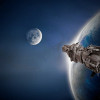



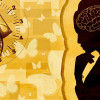





Comments
Add a comment